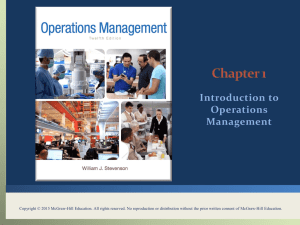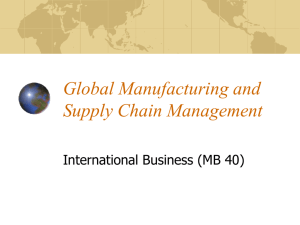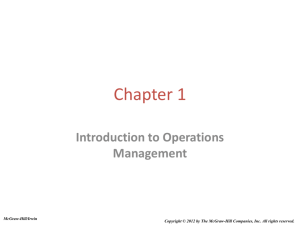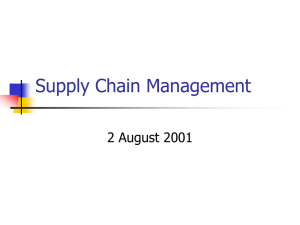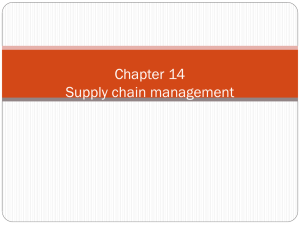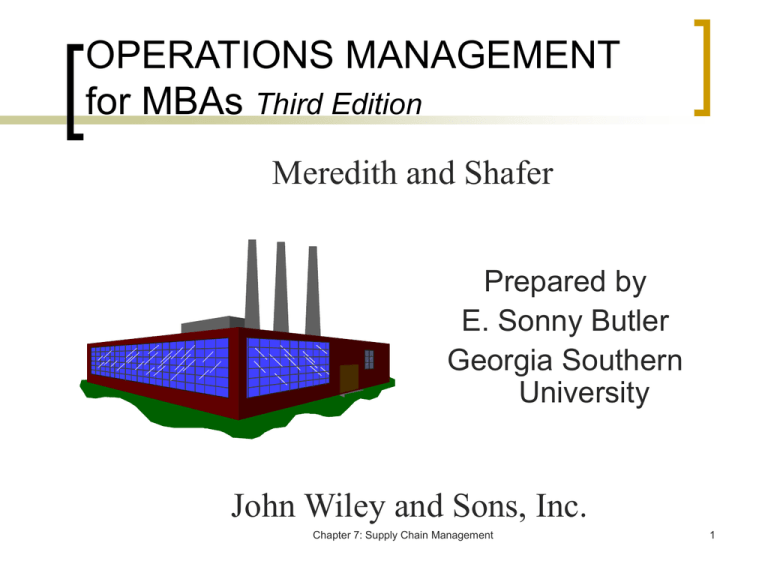
OPERATIONS MANAGEMENT
for MBAs Third Edition
Meredith and Shafer
Prepared by
E. Sonny Butler
Georgia Southern
University
John Wiley and Sons, Inc.
Chapter 7: Supply Chain Management
1
Chapter 7
Supply Chain Management
Introduction
Palm Inc.
During the year 2000, Palm Inc. was selling
every PDA (computerized Personal Digital
Assistant) that wasn’t nailed down.
In the last few years, Palm has developed a
strategic supply chain management
function.
They have gone from doing business with
hundreds of suppliers to developing deep
relationships with only a few suppliers
Chapter 7: Supply Chain Management
4
Palm Inc. continued
The secret to driving the cost so low was
working closely with their suppliers to hit tight
cost targets for the display, the processor, the
memory, the battery, and the mechanicals.
The result of their new strategic emphasis on
supply chain management has been a 20-30
percent reduction in materials costs and a 27
percent reduction in overall costs, an
increase in inventory turns from 3 to 22, and
a 30 percent increase in profit margins.
Chapter 7: Supply Chain Management
5
B2B Networks and Private
Exchanges
B2B Online Marketplaces
Private Exchanges
HP
Ace Hardware
IBM
Chapter 7: Supply Chain Management
6
B2B Online Internet Marketplaces
When the Internet revolution began, a
number of organizations rushed to establish
B2B online marketplaces for entire
industries including steel, automobile
manufacturing, and electronics.
More recently, however, a number of firms
including HP, IBM, and Wal-Mart created
their own private exchanges (also called
corporate marketplaces).
Chapter 7: Supply Chain Management
7
B2B Online Internet Marketplaces
continued
These links allow the parties to
collaborate and manage the supply
chain in real time.
Ace Hardware provides another
example.
Ace's motivation for the development of
its system was the desire to manage its
inventory more efficiently and be able to
collaborate with suppliers in real time.
Chapter 7: Supply Chain Management
8
B2B Online Internet Marketplaces
continued
Ace used its supply chain management
software to link the computer systems
located in its 14 distribution centers with
nine suppliers.
IBM's system provides links to over 20,000
of its suppliers.
IBM further estimates that it realized almost
$400 million in savings that year due to the
increased efficiency of its Web-based
procurement system.
Chapter 7: Supply Chain Management
9
Dell Computer
Direct Model
Use of Information Technology
provides suppliers with access to Dell’s
inventories
Minimum Inventory Levels
Chapter 7: Supply Chain Management
10
Dell Computer
Classic case in supply chain management.
Established in 1984, Dell experienced
supply problems in 1993 and thereupon
completely redesigned its supply chain
process along the lines of what its founder,
Michael Dell, called the “direct” model.
Between 1993 and 1998, Dell's earnings
subsequently grew at 65 percent per year.
Chapter 7: Supply Chain Management
11
Dell Computer continued
Dell's supply chain redesign was based on the
following elements.
First, Dell sells directly to customers, eliminating
the wholesaler and retailer.
Second, Dell also takes advantage of new
information technologies in their communications
with suppliers who can access Dell's component
inventories, production plans, and forecasts in real
time and thus keep their production precisely
matched to Dell's needs.
Third, Dell deliberately maintains absolute
minimum inventory levels at every stage of
production, averaging 4 days overall
Chapter 7: Supply Chain Management
12
Supply Chain Management Crusade
Focus is on entire value chain
Includes
lean production
JIT
TQM
purchasing
product/service design
Chapter 7: Supply Chain Management
13
Defining Supply Chain Management
Coordination and integration of all
supply chain activities into seamless
process.
Enables organizations to plan and
collaborate across supply chain.
Goal is to deliver right product to right
place at right time in order to maximize
profit.
Chapter 7: Supply Chain Management
14
Strategic Advantages of Supply Chain
Supply chain management includes the
supply, storage, and movement of
materials, information, personnel,
equipment, and finished goods within the
organization and between its
environment.
Goal of supply chain management is to
integrate the entire process of satisfying
the customer’s needs all along the supply
chain.
Chapter 7: Supply Chain Management
15
Strategic Advantages of Supply Chain
Management continued
Supply chain costs often represent 50% or
more of total operating costs
Firms that have implemented supply chain
management
Have 45% supply chain cost advantage
50% lower inventory
17% faster delivery of final product
Larger market shares and higher
customer loyalty
Chapter 7: Supply Chain Management
16
Supply Chain Strategy
Supply chain strategy needs to be tailored to
meet the needs of its customers which isn’t
always the lowest cost.
In situations where the goods are basic
commodities with standard benefits (food,
home supplies, standard clothing), then cost
reduction will be the focus.
In fashion goods, timeliness should be the
focus of the supply chain.
Chapter 7: Supply Chain Management
17
Strategic Need for Supply Chain
Management
Total supply chain costs represent better
than half, and in some cases three-quarters,
of the total operating expenses for most
organizations.
The broader concept of the supply chain
includes the supply, storage, and movement
of materials, information, personnel,
equipment, and finished goods within the
organization and between it and its
environment.
Chapter 7: Supply Chain Management
18
Strategic Need for Supply Chain
Management continued
As organizations have continued to adopt
more efficient production techniques such as
lean manufacturing, total quality
management, inventory reduction techniques
to reduce costs and improve the quality,
functionality, and speed of delivery of their
products and services to customers, the
costs and delays of procuring the requisite
inputs and distributing the resulting goods
and services are taking a greater and greater
fraction of the total cost and time.
Chapter 7: Supply Chain Management
19
Other Factors Driving Need to
Better Manage Supply Chain
Increasing global competition
Outsourcing
E-commerce
Shorter life cycles
Greater supply chain complexity
Chapter 7: Supply Chain Management
20
Measures of Supply Chain Performance
Lower inventories, will be reflected in
less need for working capital (WC) and
a higher return on asset (ROA) ratio.
Lower cost to carry these inventories
will be seen in a reduced cost of goods
sold (CGS), and thus a higher
contribution margin, return on sales
(ROS), and operating income.
Chapter 7: Supply Chain Management
21
Operations-Oriented Measures
Performance measures related to inventory
reduction:
First we calculate the aggregate inventory value (at
cost) on average for the year (AAIV):
AAIV = raw materials + work-in-process + finished
goods
% Assets in Inventories = AAIV/total assets
Another inventory measure is the inventory turnover
(or “turns,” as it is sometimes called):
Inventory turnover (“turns”) = annual cost of goods
sold/AAIV
Chapter 7: Supply Chain Management
22
Supply Chain Design
The supply chain consists of the
network of organizations that supply
inputs to the business unit, the
business unit itself, and the customer
network.
Chapter 7: Supply Chain Management
23
The Supply Chain
Chapter 7: Supply Chain Management
24
Logistics
Logistics
Planning and controlling efficient,
effective flows of goods, services, and
information from one point to another.
Chapter 7: Supply Chain Management
26
The Bullwhip Effect
Each segment further down the whip
goes faster than the one above it.
Same effect often observed in supply
chains.
Chapter 7: Supply Chain Management
27
Transportation
Modes of Transportation and Routing
Water
Rail
Truck
Air
Chapter 7: Supply Chain Management
29
Factors to Consider in Transportation
Decisions
Cost per unit
shipped
Ability to fill the
transporting vehicle
Total shipment cost
Safety of contents
Shipping time
Availability of
insurance
Perishability
Difficulty of
arranging shipment
Delivery
accommodations
Seasonal
considerations
Consolidation
possibilities
Size of product
Chapter 7: Supply Chain Management
30
Location
Besides distributing outputs to customers by
transporting them, if there is a facilitating
good, we can also locate where our
customers can easily obtain them.
Advances in information and
telecommunications technology have
allowed some pure service organizations
(i.e., those without a facilitating good) to
reach their recipients through phone, cable,
the Internet, or microwave links.
Chapter 7: Supply Chain Management
31
Trade-offs Between Transportation
and Location
Processing Natural
Resources
Large loss in size
or weight during
processing
High economies of
scale exist
Raw material is
perishable
Immobile Outputs
Chapter 7: Supply Chain Management
32
Processing Natural Resources
Organizations that process natural or basic
resources as raw materials or other
essential inputs to obtain their outputs will
locate near their resource if one of the
following conditions holds:
There is a large loss in size or weight during
processing.
High economies of scale exist for the product.
The raw material is perishable.
Chapter 7: Supply Chain Management
33
Immobile Outputs
The outputs of some organizations
may be relatively immobile, such as
dams, roads, buildings, and bridges.
The organization locates itself at the
construction site and transports all
required inputs to that location
Chapter 7: Supply Chain Management
34
Distribution Requirements Planning
The distribution process is illustrated
on the next slide where retailers order
from local warehouses, the
warehouses are supplied from regional
centers, and the regional centers draw
from the central distribution facility,
which gets its inventory directly from
the factory.
Chapter 7: Supply Chain Management
35
Distribution Requirements Planning (DRP)
Chapter 7: Supply Chain Management
36
Purchasing/Procurement
Purchasing
Activities to reliably obtain materials by the
time they are needed in the product supply
process.
Important considerations include price,
quality, lead times, and reliability.
Manufacturing organizations spend an
average of 55 percent of revenue for outside
materials and services.
These same organizations spend only 6
percent on labor and 3 percent on overhead.
Chapter 7: Supply Chain Management
38
Purchasing Versus Procurement
Purchasing implies a monetary
transaction.
Procurement is simply the
responsibility for acquiring the goods
and services the organization needs.
Chapter 7: Supply Chain Management
39
Potential for Lowering Cost and
Increasing Profits
Total sales = $10,000,000
Purchased materials =
7,000,000
Labor and salaries =
2,000,000
Overhead =
500,000
Profit =
500,000
Chapter 7: Supply Chain Management
40
To Double Profits ...
Increase sales by 100 percent
Increase selling price by 5 percent
Decrease labor and salaries by 25
percent
Decrease overhead by 100 percent
Decrease purchase cost by 7.1
percent
Chapter 7: Supply Chain Management
41
JIT and Purchasing
Widespread use of JIT has increased
importance of purchasing and procurement
since delays in the receipt of materials will
stop a JIT program dead in its tracks.
Chapter 7: Supply Chain Management
42
Differences Between Purchasing by
Individuals and Organizations
Organizations purchase larger volumes and
dollar amounts.
Organization may be larger than its
suppliers.
Very few suppliers exist for certain
organizational goods, whereas many
typically exist for consumer goods.
Certain discounts may be available to
organizations.
Chapter 7: Supply Chain Management
43
Value Analysis
A special responsibility of purchasing, or
purchasing working jointly with
engineering/design and operations (and
sometimes even the supplier), is to regularly
evaluate the function of purchased items or
services, especially those that are
expensive or used in high volumes.
The goal is to either reduce the cost of the
item or improve its performance.
Chapter 7: Supply Chain Management
44
Key Elements of Effective Purchasing
They leverage their buying power.
They commit to a small number of
dependable suppliers.
They work with and help their suppliers
reduce total cost.
Chapter 7: Supply Chain Management
45
Supplier Management
Supplier Selection and Vendor Analysis
Characteristics of a good supplier are:
Deliveries are made on time and are of
the quality and in the quantity specified.
Prices are fair, and efforts are made to
hold or reduce the price.
Able to react to unforeseen changes.
Supplier continually improves products
and services.
Supplier is willing to share information and
be an important link in the supply chain.
Chapter 7: Supply Chain Management
47
Supplier Relationships
In the past, most customers purchased
from the lowest bidders who could
meet their quality and delivery needs.
Customers are seeking a closer, more
cooperative relationship with their
suppliers.
Chapter 7: Supply Chain Management
48
Supplier Certification and Audits
Sole-sourcing arrangements are
becoming virtual partnerships with the
customer.
This means longer-term relationships.
Suppliers are being certified or
qualified so that their shipments do not
need to be inspected by the
customer—the items go directly to the
production line.
Chapter 7: Supply Chain Management
49
Outsourcing and Global Sourcing
Outsourcing is the process of
contracting with external suppliers for
goods and services that were formally
provided internally.
Global sourcing is an important aspect
of supply chain outsourcing strategy
and we see it occurring more and
more.
Chapter 7: Supply Chain Management
50
Primary Reasons Outsourcing Occurring
1. The fall of communism and the economic
insulation it had maintained.
2. The advent of telecommunications and
computer technology that physically allowed
work that previously had to be done locally or
regionally to now be conducted overseas.
Outsourcing in general is a major strategic
element of SCM these days, not just for
production materials but for a wide range of
services as well.
Chapter 7: Supply Chain Management
51
The Role of Information Technology in
Supply Chain Management
Role of Information Technology
In the not-too-distant past, the primary
means of communication between members
of a supply chain was paper.
One problem with paper-based systems has
been the time and money that is wasted rekeying the same information into different
computer systems.
Much of this problem has been solved with
UPC and RFID being used extensively.
Chapter 7: Supply Chain Management
53
Role of Information Technology
More and more computing power is
becoming available for less and less money,
hence it is becoming omnipresent, appearing
everywhere we go and in everything we buy.
Growth of networks.
As a result the growth of computers, which
support networks, and networks that support
people’s needs (business transactions,
communication, blogging, etc.), has
exploded.
Chapter 7: Supply Chain Management
54
Electronic Business
(e-business) is the use of electronic
information technology to help various
groups of business people
communicate and conduct business
transactions.
Three primary advantages:
enhanced productivity and reduced costs
Speed
creation of new value opportunities
Chapter 7: Supply Chain Management
55
E-Commerce
Traditional means of communication was paper
Electronic commerce is a term used to describe a
variety of approaches for conducting business in a
paperless environment
Electronic Data Interchange (EDI)
Bar Coding and Scanning
Databases
Email
Electronic funds transfer
Internet
Point of sale terminals
ERP systems
RFID
Chapter 7: Supply Chain Management
56
Internet
The most significant information technology
development for supply chain management.
The Web will be the global infrastructure for
electronic commerce.
The Web will allow various forms of
purchasing fulfillment to take place, from
placing electronic catalogues on a Web site to
holding joint purchasing bazaars, exchanges,
and auction marketplaces involving massive
amounts of materials
Chapter 7: Supply Chain Management
57
Intranets
Web-based networks that allow all
employees of a firm to intercommunicate.
They are usually firewall protected and use
existing Internet technologies to create
portals for company-specific information and
communication, such as newsletters,
training, human resource information and
forms, product information, and so on.
Chapter 7: Supply Chain Management
58
Extranets
Private networks to allow the
organization to securely interact with
external parties.
They use Internet protocols and public
telecommunication systems to work
with external vendors, suppliers,
dealers, customers, and so on.
Chapter 7: Supply Chain Management
59
Customer Relationship
Management (CRM) Systems
Designed to collect and interpret
customer-based data.
CRM systems provide comprehensive
customer data so the firm can provide
better customer service and design and
offer the most appropriate products and
services for them.
Chapter 7: Supply Chain Management
60
Enterprise Resource Planning
(ERP) Systems
Facilitate communication throughout
the supply chain and over the Internet.
The ERP system embodies much
more than just the supply chain, it also
includes all the electronic information
concerning the various parts of the
firm.
Chapter 7: Supply Chain Management
61
Successful Supply Chain Management
The basic requirements for successful
supply chain management are
trustworthy partners, good
communication, appropriate
performance measures, and
competent managers with vision.
Chapter 7: Supply Chain Management
62
Examples of Visionary SCM Innovations
Dell’s “direct model” and Palm’s “strategic
sourcing”.
Wal-Mart’s “cross-docking” technique of offloading goods from incoming trucks at a
warehouse directly into outbound distribution
trucks instead of being placed into inventory.
“delayed differentiation” where final
modules are either inventoried for lastminute assembly to customer order, or
differentiating features are added to the final
product upon receipt of the customer’s order.
Chapter 7: Supply Chain Management
63
Examples of Visionary SCM Innovations
continued
Sport Obermeyer’s and HewlettPackard’s “postponement” approach
to delayed differentiation where variety
and customization is delayed until as
late in the production process as
possible, sometimes even arranging
with the carrier to perform the final
customization (called channel
assembly).
Chapter 7: Supply Chain Management
64
Chapter 7: Supply Chain
Management
65
Copyright
Copyright 2006 John Wiley & Sons, Inc. All rights reserved.
Reproduction or translation of this work beyond that named in
Section 117 of the United States Copyright Act without the
express written consent of the copyright owner is unlawful.
Requests for further information should be addressed to the
Permissions Department, John Wiley & Sons, Inc. Adopters of
the textbook are granted permission to make back-up copies
for their own use only, to make copies for distribution to
students of the course the textbook is used in, and to modify
this material to best suit their instructional needs. Under no
circumstances can copies be made for resale. The Publisher
assumes no responsibility for errors, omissions, or damages,
caused by the use of these programs or from the use of the
information contained herein.
Chapter 7: Supply Chain Management
66



